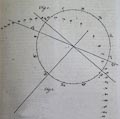




Precepts to determine the Course of the Comet.
Precepts for determining, from one single Observation, the whole apparent course of the expected Comet, with directions in what part of the Heavens to look for it every Month in the Year.
ON a large sheet of pasteboard describe a circle ten inches radius, to represent the earth's orbit round the sun, as in Fig. 1. which divide into 360 degrees, and distinguish the signs by their proper characters. Then. with the sun, or center, as a focus, and the true perihelion place and distance, draw a parabola like that deduced from the observations of the comet of 1682, and thereon mark every 4th days motion from the perihelion, on either side, and draw a line of the nodes; these elements, as also the inclination of the orbit, may be found in Dr Halley's table or list of comets.


Set off the cosine of the inclination on perpendiculars to the line of the nodes, towards the several fourth days marks or points in the parabola; these will form the projection of the parabola, or comet's trajectory, on the plane of the ecliptic, over which the comet is at any time perpendicular.
To find the comet's place at any time, count how long it is before or after its perihelion, and mark the place in the projection of the parabola: lay one edge of a parallel ruler through that point, and also through the point of the earth's place in its orbit at that time, and the other edge passing thro' the sun, will cut the earth's orbit at the comet's geocentric place.
The tangent of the inclination, taking the perpendicular from the comet'splace to the line of the nodes as radius, is the tangent of its apparent latitude, making the curtate distance of the comet from the earth, the radius.
For expedition thus: draw two lines, making an angle of 17d. 56m. equal to the inclination. On one of them set off the perpendicular from the comet's projected place, and raise aperpendicualr to the other; or, which is the same, from the comet's real place in the parabola, and let fall a perpendicular, which will be the tangent of its geocentric latitude.
One observation of a known comet will, by the help of such a scheme, determine, in good measure, its whole course: for, from the earth's place in its orbit draw the observed longitude of the comet, and where that cuts the projection of the parabola, there is the comet's place; to which if the observed latitude agrees, it confirms it. Then, the other data being already known, and one place given, its whole course may be traced.


 Gents Mag 1756 p.413
Gents Mag 1756 p.413